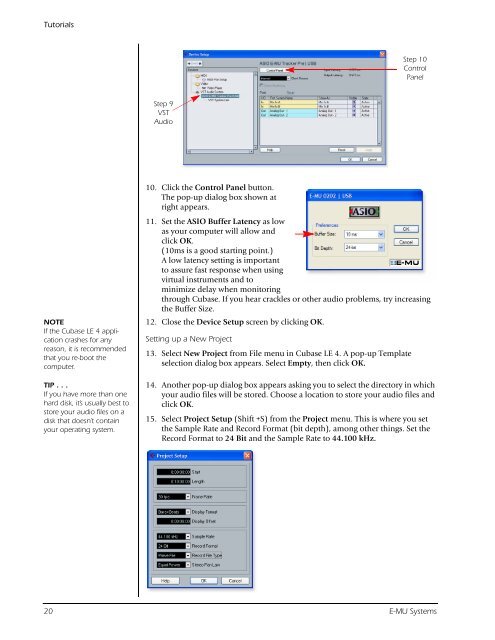Audio Interface / Mobile Preamp - zZounds.com
Audio Interface / Mobile Preamp - zZounds.com
Audio Interface / Mobile Preamp - zZounds.com
You also want an ePaper? Increase the reach of your titles
YUMPU automatically turns print PDFs into web optimized ePapers that Google loves.
Tutorials<br />
NOTE<br />
If the Cubase LE 4 application<br />
crashes for any<br />
reason, it is re<strong>com</strong>mended<br />
that you re-boot the<br />
<strong>com</strong>puter.<br />
TIP . . .<br />
If you have more than one<br />
hard disk, it’s usually best to<br />
store your audio files on a<br />
disk that doesn’t contain<br />
your operating system.<br />
Step 9<br />
VST<br />
<strong>Audio</strong><br />
10. Click the Control Panel button.<br />
The pop-up dialog box shown at<br />
right appears.<br />
11. Set the ASIO Buffer Latency as low<br />
as your <strong>com</strong>puter will allow and<br />
click OK.<br />
(10ms is a good starting point.)<br />
A low latency setting is important<br />
to assure fast response when using<br />
virtual instruments and to<br />
minimize delay when monitoring<br />
through Cubase. If you hear crackles or other audio problems, try increasing<br />
the Buffer Size.<br />
12. Close the Device Setup screen by clicking OK.<br />
Setting up a New Project<br />
13. Select New Project from File menu in Cubase LE 4. A pop-up Template<br />
selection dialog box appears. Select Empty, then click OK.<br />
Step 10<br />
Control<br />
Panel<br />
14. Another pop-up dialog box appears asking you to select the directory in which<br />
your audio files will be stored. Choose a location to store your audio files and<br />
click OK.<br />
15. Select Project Setup (Shift +S) from the Project menu. This is where you set<br />
the Sample Rate and Record Format (bit depth), among other things. Set the<br />
Record Format to 24 Bit and the Sample Rate to 44.100 kHz.<br />
20 E-MU Systems

















